Abstract
Gait analysis refers to the systematic study of human locomotion and finds numerous applications in the fields of clinical monitoring, rehabilitation, sports science and robotics. Wearable sensors for real-time gait monitoring have emerged as an attractive alternative to the traditional clinical-based techniques, owing to their low cost and portability. In addition, 3D printing technology has recently drawn increased interest for the manufacturing of sensors, considering the advantages of diminished fabrication cost and time. In this study, we report the development of a 3D-printed capacitive smart insole for the measurement of plantar pressure. Initially, a novel 3D-printed capacitive pressure sensor was fabricated and its sensing performance was evaluated. The sensor exhibited a sensitivity of , a wide working pressure range , excellent stability and durability (at least cycles), great linearity (), fast response/recovery time , low hysteresis and the ability to support a broad spectrum of gait speeds steps/min). Subsequently, 16 pressure sensors were integrated into a 3D-printed smart insole that was successfully applied for dynamic plantar pressure mapping and proven able to distinguish the various gait phases. We consider that the smart insole presented here is a simple, easy to manufacture and cost-effective solution with the potential for real-world applications.
1. Introduction
Human gait, as natural and as simple as it seems, is the product of a complicated and cooperative process involving the brain, spinal cord, nerves, muscles, bones and joints. Gait is a typical activity for healthy human beings but also characteristic of a person’s style and quality of life. Proper gait functionality is essential for maintaining an abundant lifestyle, healthier and happier, while any deviation from the standard can drastically affect everyday experiences.
The study of human walking, namely gait analysis, can be used as a valuable diagnostic tool to distinguish between normal and pathological gait. Abnormal gait patterns are related to the pathology of the human locomotor system, which can be caused by various pathological conditions including neurodegenerative, musculoskeletal or other peripheral disorders [1]. For example, apraxic gait is characterized by the deterioration of neurons, loss of locomotion control and eventually inability of proper movement as a result of diseases such as Parkinson’s [2], Alzheimer’s [3] or cerebral palsy (CP) [4], etc. Limited mobility and dysfunctional gait, e.g., antalgic patterns, may be the effect of chronic musculoskeletal pain arising from age-related conditions such as knee osteoarthritis [5], osteoporotic hip fractures [6], etc. In this respect, a quantitative gait analysis at a specific moment, or through continuous monitoring and re-evaluation over time, can support early diagnosis of diseases, credible clinical decisions, optimization of treatment protocols and assessment of patient outcomes [7]. Apart from clinical applications, the reliable analysis of human gait characteristics is one of the main interests in the fields of sports science [8], rehabilitation [9], security monitoring [10] and robotics [11].
The traditional/old-fashioned approach to human gait analysis is based on the observation of a patient’s gait performed in a clinic by experienced specialists, aided with patient self-reporting. However, this method is considered unreliable and oversimplified, i.e., the evaluation is subjective and lacks of quantitativeness [1]. The progress of new technologies has given rise to more delicate, advanced techniques which allow for an accurate, objective and quantitative measurement of gait parameters [12]. The standard method for gait analysis, adopted by the majority of specialized clinics, is a vision-based motion analysis captured by digital video cameras and thoroughly analyzed through image processing techniques [13]. Alternatively or in combination, force platforms can be used to extract gait information; they are located on the floor and utilize a pressure mattress to measure ground reaction forces (GRFs) during walking [14]. Nonetheless, the aforementioned methodologies are relatively expensive, time-consuming and require expertise [15]. Moreover, the examination procedure is strictly performed to controlled environmental settings, where the patient is aware of his/her movements and usually with markers attached to the body; hence, the results do not reflect real-world activities [15].
In the last decade, wearable insole-based sensor systems have shown great potential as gait analysis tools, intending to overcome the aforementioned limitations of stationary force platforms [16,17,18]. These wearable technologies allow for continuous gait monitoring in both indoor and outdoor environments on a daily basis without any constraints on an individual’s natural gait during measurements. Most often, they are used to measure the plantar pressure distribution, despite the fact that other gate features can also be obtained, including the center-of-pressure (CoP), step count, duration of gait cycle, swing and stance duration [19]. Insole-based plantar pressure sensors produce an electrical signal upon pressure loading during human gait. Based on their working mechanism, they can be divided into three major, widely used types: piezoelectric [20,21,22], piezoresistive [23,24,25,26] and capacitive [27,28,29,30]. Each sensing mechanism exhibits its own merits and limitations [16,18], none of them has a clear edge and it is rather hard to develop a sensor device with ideal characteristics [31]. The basic parameters to determine the performance of plantar pressure detection sensors are sensitivity, linearity, range of detection, response time, hysteresis, stability, durability and interferences from external sources such as temperature, humidity or electromagnetic interference [32]. Apart from sensor performance characteristics, multiple factors have to be considered prior to the development of a new insole sensing system, including sensing elements layout, electronics circuit design, signal processing algorithms, energy consumption, manufacturing cost and user comfort [7,16,18].
Capacitive pressure sensors have been established as a compelling candidate for insole-based plantar pressure monitoring due to their simple structure, low power consumption, good reliability, repeatability and dynamic performance [16,17,33]. Nonetheless, their performance can be affected by humidity, temperature and electromagnetic interference [16]. Many attempts have been made over the years to integrate capacitive pressure sensors into smart insoles. In order to increase plantar pressure sensitivity, capacitive sensors with porous polydimethylsiloxane (PDMS) as the dielectric material have been repeatedly presented in the literature [34,35,36]. In another approach, Zhang et al. developed a low-cost, capacitive-based plantar pressure sensor composed entirely of fabric [37]. Tao et al. established a real-time pressure mapping smart insole system with a rubber dielectric layer and studied various motions and postures [29]. Aqueveque et al. presented a gait segmentation method using a custom-made capacitive insole [28]. Sorrentino et al. developed a capacitive insole prototype with temperature compensation and high spatial resolution [27]. Recently, De Guzman et al. created a low-cost, capacitive insole for plantar pressure measurement as a possible alternative to more expensive systems [30]. However, the insoles presented in the aforementioned studies are characterized by complex and expensive fabrication processes or inadequacy for cost-effective mass production. In addition, a few capacitive-based insole products have become commercially available in the last two decades. For example, the Pedar® (Novel GmbH, Munich, Germany) pressure distribution measuring system is a widely used and well-tested in-shoe device based on 99 capacitive sensors [38,39,40]. Another product worth mentioning is Moticon’s (Moticon GmbH, Munich, Germany) OpenGo® sensor insole system which consists of 16 capacitive pressure sensors and is capable of measuring plantar pressure distribution and acceleration in three dimensions [41,42,43]. PODOSmart® (Digitsole SAS, Nancy, France) insoles have also been validated for normal walking measurements using a stereophotogrammetry-based system [44]. Despite the above solutions having been proven in terms of accuracy and repeatability, they are characterized by a relatively high cost.
In recent years, the application of three-dimensional (3D) printing technology for the manufacturing of sensors has attracted a significant amount of research interest both in industry and academia [45]. When compared to traditional semiconductor processing techniques, 3D printing offers several advantages, including lower fabrication costs, reduced manufacturing time, lesser number of processing steps, a range of different materials and prototypes that can be easily customized according to application [46]. Various types of 3D-printed sensors such as force, acoustic and ultrasonic, optical and electromagnetic have been developed for engineering [45,47] and biomedical applications [46,48,49]. Several 3D-printed capacitive-based, flexible strain and tactile sensors can be found in the literature [50,51], but to the best of our knowledge, a 3D-printed capacitive smart insole for plantar pressure monitoring has not been developed up to now.
In this study, we present the development of a 3D-printed smart insole suitable for plantar pressure monitoring. The insole incorporates 3D-printed pressure sensors based on the capacitive sensing principle. At first, the capacitive sensors were tested under dynamic loading conditions to assess their performance by measuring their principal characteristics. These include sensitivity, linearity, pressure detection range, durability, stability, hysteresis and response/recovery time. The 3D-printed sensors were integrated into a 3D-printed insole, demonstrating the potential use of the system for recording gait-related data.
2. Materials and Methods
2.1. A 3D-Printed Capacitive Pressure Sensors
Capacitive pressure sensors were fabricated using 3D printing technology, employing the Fused Filament Fabrication (FFF) method. Specifically, 3D printing was performed with the TENLOG TL-D3 Pro Dual Extruder 3D Printer (TENLOG 3D solutions, Shenzhen, China). The sensors were designed via the Fusion 360 CAD software (Autodesk, San Rafael, CA, USA), while the Ultimaker Cura 4.6.2 software (Ultimaker B.V., Utrecht, The Netherlands) was used for the slicing of the object into layers.
Capacitive pressure sensors consist of two conductive plates separated by a dielectric material. As it is shown in Figure 1, the in between section of the two plates consists of two dielectric materials, in separate levels: First, an air cavity with a thickness of 1.0 mm and then a 0.2 mm solid flexible material (Filaflex 70A). This architecture was chosen as it offers greater sensitivity than the classic plate–dielectric–plate structure [52]. We should mention here, that prior to the presented architecture, we had already tested various versions of the classic capacitive structure (data not shown), where the dielectric was either solid or had a grid pattern (20% to 100% infill). However, in this case the system demonstrated a poor signal response/sensitivity. In general, the pressure sensitivity of a capacitive pressure sensor can be expresses as [34]:
where is the change in capacitance, is the initial capacitance without the application of pressure and is the pressure change.
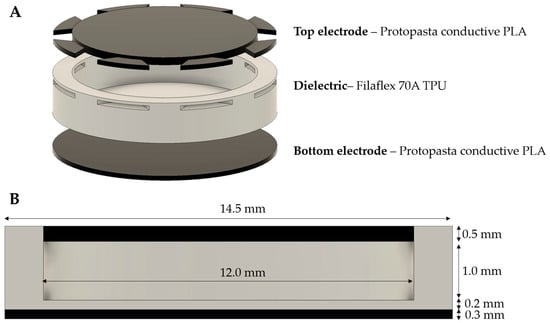
Figure 1.
(A) Layers of the structure and (B) cross-section of the 3D-printed capacitive pressure sensor.
The optimized model of the capacitive pressure sensor incorporates two conductive plates made of Protopasta CDP11705 composite conductive PLA (Protoplant, Vancouver, Canada) while the middle dielectric layer is made of Filaflex 70A TPU (Recreus Industries S.L., Elda, Spain) (Figure 1). The overall thickness of the sensor is and its diameter with layers of the following thicknesses: bottom electrode—, top electrode— and dielectric in total—. The settings for the 3D printing of the different materials used for the fabrication of the capacitive pressure sensors are summarized in Table 1.

Table 1.
Printing parameters applied for the 3D printing of the different materials.
The capacitance for two dielectric layers in series can be found easily from basic electrodynamics equations [53] and expressed as:
where is the dielectric constant of free space, is the area of the plate, are the thicknesses of the two dielectric materials and are the relative permittivity of the two dielectrics, respectively.
When pressure is applied on the capacitance sensor, the two plates (top and bottom) come closer. Thus, the total distance () between the two electrodes is reduced on the system and the capacitance changes (Equation (2)).
On both plates, we fix the cables with an adhesive conductive glue and on top of the glue we place a small piece of insulation tape as a protective layer.
2.2. Experimental Set-Up for Dynamic Measurements
An in-house experimental set-up was designed and manufactured to facilitate dynamic measurements by simulating a pressure point. This is performed through an aluminum shaft (piston) that moves up and down. The shaft moves through a flanged linear ball bearing (8 mm), which is fixed on the structure (wooden crate). The sensor is located on the bottom side of the structure, just below of the shaft’s tip (area of the tip is equal to the area of sensor). On the top part of the shaft, the crate supports the installment of a pulley system that enables the movement of the shaft on the vertical axis (Figure 2). Additionally, the pulley system is easily disengaged from the shaft in order to place on it 0.5 kg disk weights. In this direction, the pulley system transmits the motion to the piston through a stepper motor (Nema 23 57BYGH115 from Wantai motors), which is located on the side of the crate, and is connected to a motor driver (TB6600), both controlled by an Arduino Nano system (Arduino LLC, Boston, MA, USA). This way, the shaft applies periodic force on the sensor. Two potentiometers control the speed and the elevation of the shaft, which are modified in real time. The gait speed is displayed on a microdisplay (1.3″ OLED Display Module from Waveshare) as steps per minute per foot. A second Arduino Nano board is used for the system’s output acquisition and data are recorded using a code written with the open-source Arduino software language (IDE). The total time of the measurement and the sampling period are defined by the user. The sensor is fixed at this position with adhesive tape (3M™ Acrylic Adhesive 300MP) before the experiment initiation. The set-up makes it possible to measure the sensor’s response as a function of different mass loading conditions ranging from 0.7 (weight of shaft) to 14.7 kg (which in pressure units is to ). The environmental conditions of the sensor tests were 20 °C and 55–60% humidity.
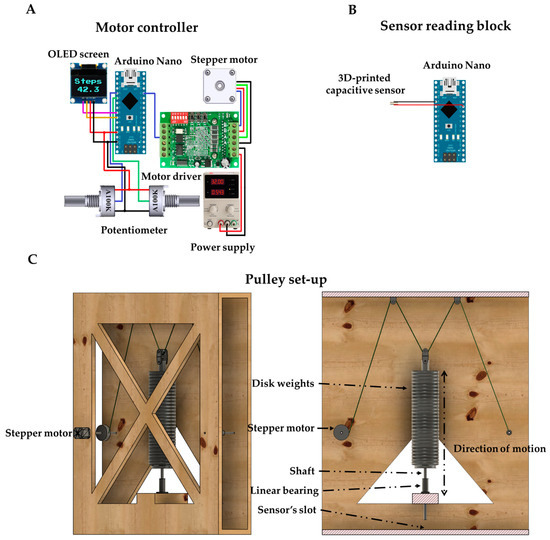
Figure 2.
Experimental set-up for dynamic measurements; (A) motor control circuit, (B) capacitive sensor reading block and (c) pulley set-up system.
2.3. A 3D-Printed Smart Insole
The fabricated 3D-printed capacitive pressure sensors were used for the design and development of a 3D-printed smart insole. The architecture, circuit connection and images of the 3D-printed capacitive smart insoles are presented in Figure 3. The upper and lower layer of the insole are made of Filaflex 82A (Recreus Industries S.L., Elda, Spain) and the printing parameters are the same as those presented in Table 1. Each insole incorporates 16 capacitive pressure sensors which are fixed to the lower flexible case and adequately electrically connected. The sensors are distributed in the insole as depicted in Figure 3A. The total thickness of the insole is , with a length up to and width up to , corresponding to a size shoes. The two layers (upper and lower) are glued together at the perimeter of the insole.
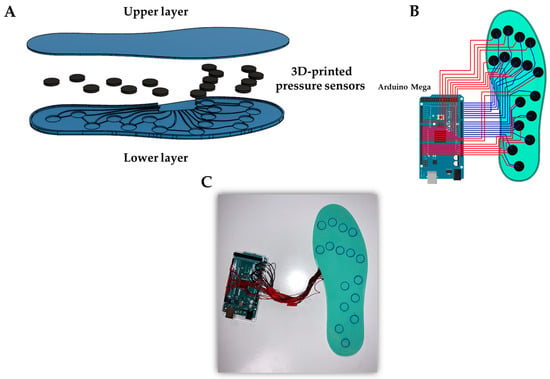
Figure 3.
Schematic illustration of 3D-printed smart insole; (A) general structure, (B) electrical circuit and (C) image of the capacitive 3D-printed smart insole.
2.4. Smart-Insole Graphical User Interface (GUI) Implementation
The GUI presented in the current investigation is a Java-based desktop application developed in IntelliJ IDEA [54]. It makes use of a “lightweight” GUI Framework, called “Swing”, which contains a set of classes to provide powerful and flexible GUI components [55]. The application communicates with the insole, and particularly with the electronics module, with the use of the Serial Communication protocol, through a USB cable, or, alternatively, a wireless Bluetooth module working as a serial (Rx/Tx) pipe. It receives and converts in real-time the sensor readings, acquired from the A/D converter of the electronics module, into pressure values, and subsequently, it presents in a graphical manner the pressure variations of each individual sensor and the center of pressure (CoP) in total too. In the implementation of the individual pressure variations, the insole, scaled into the monitor resolution, is divided into 227 grids as shown in the middle of Figure 4. Then, a group of nearby grids is assigned to every sensor, which, depending the current pressure value, change color accordingly, with yellow indicating the lowest and red the highest pressure. Next to the grid implementation, the individual pressure values may also be presented in a chart-type implementation as shown at the left and the right side of Figure 4.
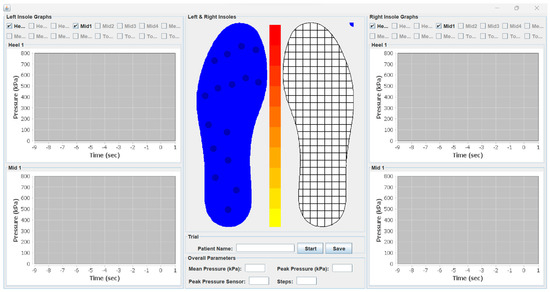
Figure 4.
Smart insole graphical user interface (GUI) implementation.
3. Results and Discussion
3.1. Sensor Evaluation
In order to evaluate the sensing performance of the 3D-printed capacitive pressure sensors, we conducted a series of experiments that enabled to assess their basic characteristics. The real-time sensor responses under dynamic pressure loading were used to obtain an estimation of their sensitivity, both in and out of the insole. In addition, we investigated other key parameters correlated to sensor performance including linearity, limit of detection (LoD), detection range, effect of loading frequency, stability, durability, repeatability, hysteresis, response and recovery time. In this manner, their potential for practical applications such as plantar pressure monitoring was verified.
3.1.1. Real-Time Measurements
The real-time capacitance changes of a typical 3D-printed capacitive pressure sensor as a function of varying external pressure are demonstrated in Figure 5. The dynamic experiments were performed under a loading frequency that was kept constant at . The applied pressure ranged from to with an incremental increase of , while one-minute recordings were obtained at every pressure. In these graphs, we present the dynamic responses of the sensors at selected pressure values under three loading/unloading cycles. As observed, the capacitance response gradually increases with pressure and its value is clearly distinctive among all steps. Moreover, the sensor is characterized by a stable and repeatable capacitance response under every pressure in the range tested. The results indicate that the sensors can efficiently operate at this pressure range without any damage, since in all cases they rapidly recover to their initial baseline value.
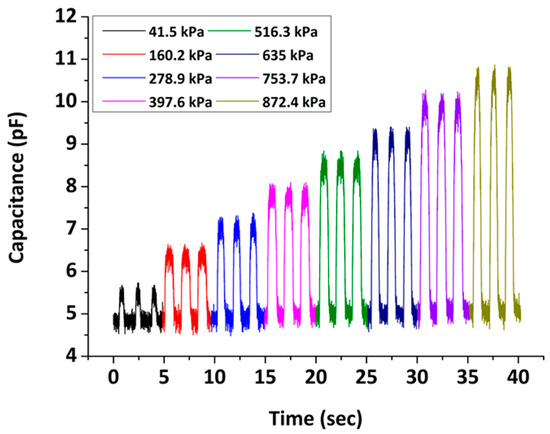
Figure 5.
Real-time capacitance response of a typical 3D-printed capacitive pressure sensor at different external pressures under three loading/unloading cycles.
3.1.2. Sensitivity
In order to assess the sensitivity of the 3D-printed capacitive pressure sensors, we measured their relative responses versus external pressure. In Figure 6, the relative capacitance change, the average of 16 sensors, is presented under varying external pressures ranging from to , using a step of . In this range, the mean sensor response was proved to be linear with pressure, while the slope of the curve was used to estimate the sensitivity. As shown in Figure 6, the average sensitivity of the capacitive sensors is , showing a great linear trend ( under the pressure range tested up to . The LoD is , which means that below this point it is not possible to reliably detect any pressure changes. The sensitivity found here is higher than that of other capacitive pressure sensors with similar working pressure ranges reported previously in the literature [34,37]. Our results suggest that the developed capacitive sensors are well-suited for applications with a broad pressure range.
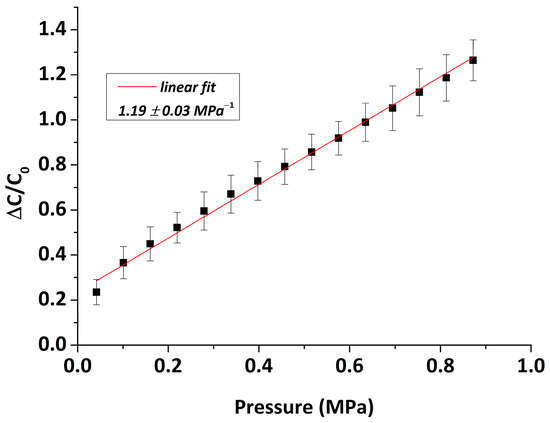
Figure 6.
Average relative capacitance variation of 16 sensors as a function of the external pressure applied ; the red line represents a linear fit of slope .
3.1.3. Loading Frequency
Considering the specific application envisaged for the capacitive pressure sensors, i.e., gait analysis, it is important to verify the sensor response at different loading frequencies, which correspond to altering gait speeds. In this direction, Figure 7 shows the capacitance response of a typical 3D-printed capacitive pressure sensor as a function of different loading frequencies under a pressure load of . The range of the tested gait speed is between and , simulating slow, normal, fast and dynamic gait. As shown, no dependence of the sensor response was found on the gait speed. This means that the operation of the capacitive sensor remains stable regardless of the gait pace. In this graph, the initial and final capacitance values are depicted, as well as their difference .
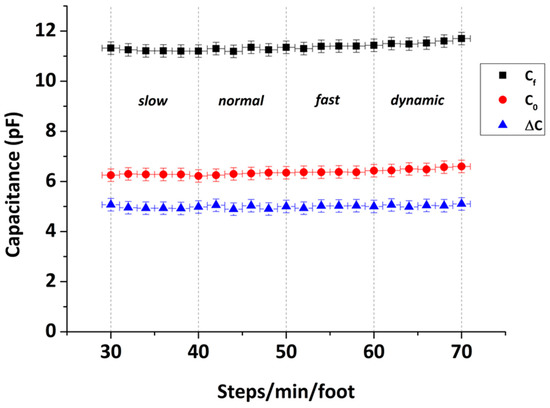
Figure 7.
Capacitance response of a typical 3D-printed capacitive pressure sensor at different gait speeds under an applied pressure of ; initial value, final value and .
3.1.4. Durability
In Figure 8, we present the capacitive sensor response during 1 h of continuous measurements of loading/unloading) under an applied pressure of . The experiment is used as a reliability test in order to assess the durability of the capacitive sensor. The inset figures demonstrate the first and final minute of the measurements. As seen, the response of and remains the same, confirming the excellent stability and durability of this type of sensor.
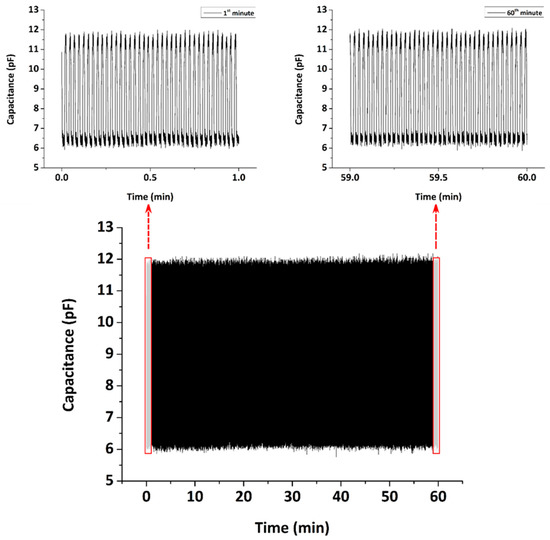
Figure 8.
Capacitance response of a typical 3D-printed capacitive pressure sensor during 1 h of continuous measurements at gait speed under an applied pressure of .
3.1.5. Hysteresis
Hysteresis is a critical parameter to be evaluated considering the practical applicability of any pressure sensor. Hysteresis can be defined as the difference in the output signal between consecutive loading and unloading cycles [56]. Negligible or low hysteresis is a desirable property that allows for consistent and accurate measurement of pressure variations over time. Due to the fact that the sensor has to operate under repeated dynamic conditions, potential unrecoverable deformations could introduce significant measurement errors. Figure 9 depicts the measured hysteresis curves, forward and reverse, as obtained from three consecutive linear loading–unloading pressure cycles. According to this graph, two different responses are distinguished with the unloading curve being slightly higher compared to the loading cycle. Nevertheless, the sensor only exhibits low hysteresis, indicating its capability to obtain reliable and accurate pressure signals.
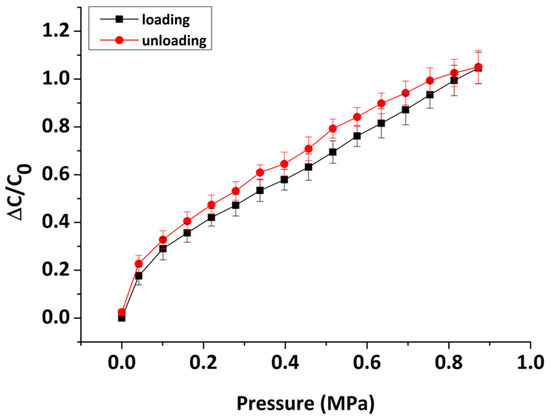
Figure 9.
Hysteresis curves of the sensor obtained from three consecutive linear loading–unloading cycles of pressure.
Quantitively, hysteresis can be assessed using the equation for the degree of hysteresis (DH) which is defined as the percentage of the relative difference in the area underneath the loading and unloading curves, calculated by the following equation [56]:
where and are the areas underneath the curves in Figure 9, corresponding to the loading and unloading cycles, respectively. For our sensor, the DH value was estimated to be , implying a relatively good hysteresis level.
3.1.6. Response/Recovery Time
Real-time pressure monitoring requires sensors that exhibit fast response and recovery times. Response time is the interval needed for the sensor output to reach its final value upon a pressure change. Reversely, recovery time is the interval required for a sensor to return to its base value upon pressure release. In this study, the response time was estimated as the time in which the capacitance changes from to of its maximum change upon pressure loading while the recovery time was from to upon pressure unloading [57]. The response/recovery time can be seen in Figure 10, where the sensor response is presented under the loading–unloading of . As illustrated, the response/recovery time of our device was found to be in the millisecond range. Specifically, the sensor can detect pressure changes with a response time of and a recovery time of . This means that the developed sensing device can successfully monitor plantar pressure variations, at least in cases where the stride frequencies are in the range of 30–70 steps/min. The response/recovery time found in this study is similar to that of other capacitive pressure sensors [29,35].
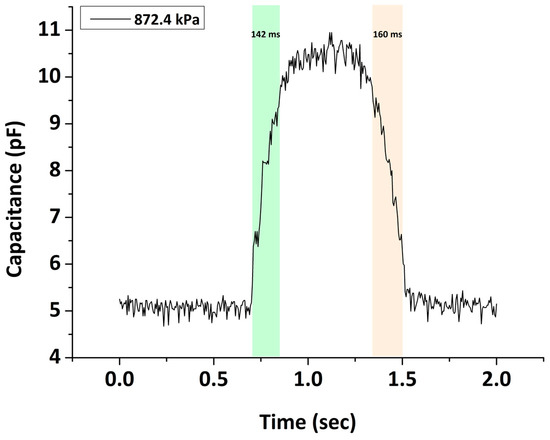
Figure 10.
Sensor response and recovery times under an applied pressure of .
3.1.7. Insole Sensitivity
Since the capacitive pressure sensors developed in this research are meant to be fixed inside an insole, one should consider investigating the effect of the insole and electrical connections on the sensor’s performance. For this purpose, the same sensors were placed inside the designed 3D-printed insole and re-calibration was performed using the same experimental parameters (see Section 3.1.2). The average relative capacitance change ratio of sixteen sensors as a function of increasing applied pressure, both outside and inside the insole, is presented in Figure 11. Again, the slope of the curve reveals the average sensitivity of the capacitive pressure sensor. As anticipated, the insole has a noticeable impact on the sensor’s response, i.e., the sensitivity decreases , specifically from to . Even so, the linearity is still high , and the working pressure range remains the same while the average error level drops to . The insole sensitivity may be further improved by reducing the thickness of the insole’s upper/lower cases and minimizing the electrical noise by upgrading/optimizing the external electrical circuit and hardware.
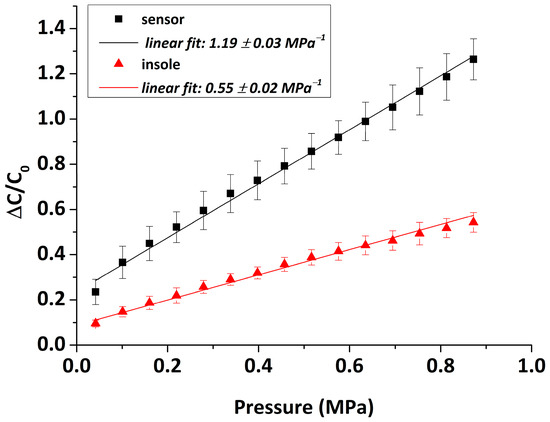
Figure 11.
Average relative capacitance response of the 3D-printed capacitive pressure sensors as a function of the applied pressure measured outside (black) and inside the insole (red). The slopes correspond to the sensitivities.
3.2. Plantar Pressure Mapping
To demonstrate the relevance of the developed 3D-printed capacitive pressure sensors for practical applications, we placed the sensors inside a 3D-printed smart insole, which was subsequently used for real-time plantar pressure measurements and gait analysis. The smart insole was designed to incorporate 16 pressure sensors, distributed appropriately across the main pressure areas of the foot during walking. Specifically, the sensors were fixed at four areas: phalanges (T1, T2, T3, T4), metatarsals (ME1, ME2, ME3, ME4, ME5), plantar arch (M1, M2, M3, M4) and calcaneus (H1, H2, H3). The arrangement of the sensing elements inside the smart insole is depicted in Figure 12G.

Figure 12.
Plantar pressure distribution (heatmap) of the right foot under the main phases of a normal gait cycle: (A) stance, (B) heel strike, (C) foot flat, (D) midstance, (E) heel off and (F) toe off, (G) insole sensors arrangement and color map of the pressure range.
The smart insole system was fixed at the right foot of a volunteer subject and real-time recordings were obtained during repeated gait cycles. The subject recruited for these experiments was a healthy female, , in weight and in height with a . No discomfort was reported from the volunteer while wearing the insole. The plantar pressure distribution during a dynamic gait cycle is presented in Figure 12. The heatmaps shown in this graph correspond to the main stance phases of a gait cycle including stance, heel strike, foot flat, midstance, heel off and toe off. The plantar pressure mapping is based on a color scale of ten regions , ranging from yellow (low pressure) to red (high pressure). It can be clearly seen that the developed smart insole system was able to assess dynamic pressure variations and successfully determine gait events during a gait cycle. The plantar pressure distribution changes depend on the specific gait phase. In the stance and foot flat phases, a relatively even distribution of the pressure across the foot is observed. In the heel strike stage, ground contact is initiated, which results in the activation of the heel sensors that reach their peak value while the rest of the sensor remains inactive. The midstance posture is characterized by the relocation of the pressure loading mainly on midfoot and forefoot as recorded by the metatarsal and toe sensors. During the heel off phase, the pressure is concentrated on the metatarsals zone and the big toe. Finally, as displayed in the graph, at heel off all sensors return close to zero pressure values, despite the fact that some signal drift or delay is observed. In Figure 12, the trajectory of the center-of-pressure (CoP) is also shown (blue marker) during the gait cycle and its transition through the subphases is revealed. As expected, the CoP is initially located near the heel at the time of heel strike and gradually moves forward to the forefoot near the toes at the heel off stage, indicating a regular variation of the CoP. It should be noted that a proper estimation of the CoP, its trajectory and velocity, is an important parameter to evaluate the balance ability of an individual.
The real-time plantar pressure signals, as collected from the sixteen sensors of the insole during the normal gait cycle, are displayed in Figure 13. All heel sensors are activated at the first three phases, namely stance, heel strike and foot flat with the highest amplitude of pressure measured at sensor H1 during heel strike . The hallux area, represented here by the sensing element T4, experienced a pressure value of in the transition between midstance and heel off. At the same time point, the highest pressure value in the phalanges zone was reported at sensor T1 The metatarsals area is for the most part loaded between the end of heel strike and the start of heel off. The maximum pressure recorded in this zone was of value at sensor ME5, which is located lateral to the first metatarsal. The plantar arch received the lowest pressure and it was activated primarily at the foot flat stage with pressures remaining below . Sensors T2 and T3 of the middle toes area did not bear any pressure throughout the gait cycle. The results presented above confirm the applicability of the proposed 3D-printed smart insole system for plantar pressure monitoring in real time with adequate accuracy and time resolution. However, it should be noted that the results depend firmly on the architecture of the sensors, their position within the system (including how close they are packed together), on the manufacturing materials and on the general design of the insole and how it may absorb the pressure during a gait analysis.
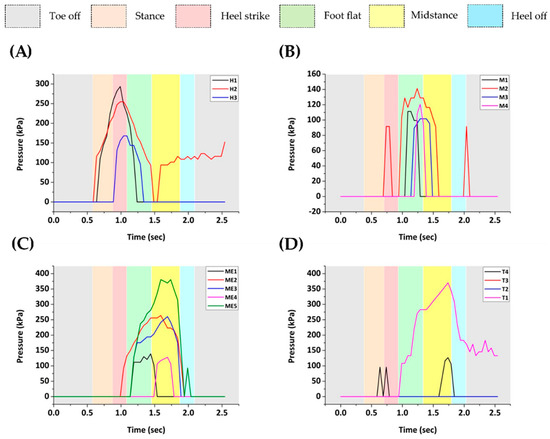
Figure 13.
Real-time plantar pressure signals obtained from the right foot of the subject during a normal gait cycle using the developed smart insole system. Sensors monitored four areas: (A) calcaneus, (B) plantar arch, (C) metatarsals and (D) phalanges.
4. Conclusions
In this work, a 3D-printed smart insole system was established, aiming to monitor the plantar pressure distribution during human gait. The insole system consists of 16 3D-printed pressure sensors employing capacitive sensing. The capacitive sensors were tested under dynamic loading conditions using a custom-built experimental set-up that was developed for gait simulation experiments. The experimental set-up allows to evaluate the response of the sensors under repeated loading/unloading cycles and by varying the loading frequency and amount of pressure. As a result, it was possible to assess the performance of the sensors in terms of real-time dynamic response, sensitivity, linearity, pressure detection range, stability, durability, hysteresis, response/recovery time and gait speed. It was confirmed that the sensors exhibit a very positive performance for their specific application, i.e., real-time human gait monitoring. Using the smart insole and dedicated software, it was possible to obtain plantar pressure maps at different gait phases, to demonstrate the capabilities of our system for gait signal analysis. Moreover, this smart insole system is characterized by a fast and low-cost fabrication process. Depending on the 3D printing systems, one can have a pair of insoles ready within a day. According to Table 2, the manufacturing costs of the 3D-printing parts per sole is a little bit less than EUR 6. The total cost of the insole pair, including the external recording unit, reaches EUR 60. Additionally, the process offers the ability to easily redesign an insole that will specifically meet the requirements of a process and the specificity of a person’s/patient’s foot. This makes the use of the aforementioned smart insole system perfect for personalized applications.

Table 2.
Analysis of the cost per sole.
Author Contributions
Conceptualization, G.M. and A.K.P.; methodology, A.G.S., G.M. and A.K.P.; software, G.C. and M.T.; validation, A.G.S., G.M., S.S. and A.K.P.; formal analysis, A.G.S., G.M. and S.S.; resources, A.K.P.; writing—original draft preparation, A.G.S., G.M. and A.K.P.; writing—review and editing, A.G.S., G.M., S.S., G.C., M.T. and A.K.P.; supervision, A.K.P.; project administration A.K.P.; funding acquisition, M.T. and A.K.P. All authors have read and agreed to the published version of the manuscript.
Funding
This research has been funded by the European Regional Development Fund of the European Union and Greek national funds through the Operational Program Competitiveness, Entrepreneurship and Innovation, under the call RESEARCH-CREATE-INNOVATE and through the grant Smart Insole (project code: T1EDK-01888).
Institutional Review Board Statement
The study was conducted in accordance with the Declaration of Helsinki, and approved by the Institutional Review Board (or Ethics Committee) of University Hospital of Patras (protocol code 279/14-5-2021 and date of approval 14.05.2021).” for studies involving humans.
Informed Consent Statement
Written informed consent has been obtained from the volunteer to publish this paper.
Data Availability Statement
The study did not report any data.
Acknowledgments
The authors would like to acknowledge the Microelectronics Research Group and FORTH for hosting all the research activities of the Smart Insole grant. In particular, we would like to thank George Konstantinidis from the Microelectronics Research Group for all the help and mentoring during this period, as well as Vereniki Mari from the Physics Department of the University of Crete who volunteered as the subject for the experiments. Additionally, we would like to thank Nikolaos Tachos from the University of Ioannina for all the fruitful discussions we had during these years. Last but not least, we would like to acknowledge all the members from the Smart Insole consortium, and especially UOI and Prisma Electronics for the collaboration.
Conflicts of Interest
The authors declare no conflict of interest.
References
- Chen, S.; Lach, J.; Lo, B.; Yang, G.Z. Toward Pervasive Gait Analysis With Wearable Sensors: A Systematic Review. IEEE J. Biomed. Heal. Inform. 2016, 20, 1521–1537. [Google Scholar] [CrossRef] [PubMed]
- Di Biase, L.; Di Santo, A.; Caminiti, M.L.; De Liso, A.; Shah, S.A.; Ricci, L.; Di Lazzaro, V. Gait Analysis in Parkinson’s Disease: An Overview of the Most Accurate Markers for Diagnosis and Symptoms Monitoring. Sensors 2020, 20, 3529. [Google Scholar] [CrossRef] [PubMed]
- McArdle, R.; Morris, R.; Wilson, J.; Galna, B.; Thomas, A.J.; Rochester, L. What Can Quantitative Gait Analysis Tell Us about Dementia and Its Subtypes? A Structured Review. J. Alzheimer’s Dis. 2017, 60, 1295–1312. [Google Scholar] [CrossRef] [PubMed]
- Armand, S.; Decoulon, G.; Bonnefoy-Mazure, A. Gait Analysis in Children with Cerebral Palsy. EFORT Open Rev. 2016, 1, 448–460. [Google Scholar] [CrossRef] [PubMed]
- Favre, J.; Jolles, B.M. Gait Analysis of Patients with Knee Osteoarthritis Highlights a Pathological Mechanical Pathway and Provides a Basis for Therapeutic Interventions. EFORT Open Rev. 2016, 1, 368–374. [Google Scholar] [CrossRef]
- Thingstad, P.; Egerton, T.; Ihlen, E.F.; Taraldsen, K.; Moe-Nilssen, R.; Helbostad, J.L. Identification of Gait Domains and Key Gait Variables Following Hip Fracture. BMC Geriatr. 2015, 15, 1–7. [Google Scholar] [CrossRef]
- Muro-de-la-Herran, A.; García-Zapirain, B.; Méndez-Zorrilla, A. Gait Analysis Methods: An Overview of Wearable and Non-Wearable Systems, Highlighting Clinical Applications. Sensors 2014, 14, 3362–3394. [Google Scholar] [CrossRef]
- Capin, J.J.; Khandha, A.; Zarzycki, R.; Manal, K.; Buchanan, T.S.; Snyder-Mackler, L. Gait Mechanics and Second ACL Rupture: Implications for Delaying Return-to-Sport. J. Orthop. Res. 2017, 35, e23476. [Google Scholar] [CrossRef]
- Marýn, J.; Blanco, T.; Marín, J.J.; Moreno, A.; Martitegui, E.; Aragüés, J.C. Integrating a Gait Analysis Test in Hospital Rehabilitation: A Service Design Approach. PLoS ONE 2019, 14, e0224409. [Google Scholar] [CrossRef]
- Singh, J.P.; Jain, S.; Arora, S.; Singh, U.P. Vision-Based Gait Recognition: A Survey. IEEE Access 2018, 6, 2879896. [Google Scholar] [CrossRef]
- Shi, D.; Zhang, W.; Zhang, W.; Ding, X. A Review on Lower Limb Rehabilitation Exoskeleton Robots. Chin. J. Mech. Eng. 2019, 32, 74. [Google Scholar] [CrossRef]
- Prakash, C.; Kumar, R.; Mittal, N. Recent Developments in Human Gait Research: Parameters, Approaches, Applications, Machine Learning Techniques, Datasets and Challenges. Artif. Intell. Rev. 2018, 49, 1–40. [Google Scholar] [CrossRef]
- Colyer, S.L.; Evans, M.; Cosker, D.P.; Salo, A.I.T. A Review of the Evolution of Vision-Based Motion Analysis and the Integration of Advanced Computer Vision Methods Towards Developing a Markerless System. Sport. Med. Open 2018, 4, 24. [Google Scholar] [CrossRef] [PubMed]
- Prosperini, L.; Pozzilli, C. The Clinical Relevance of Force Platform Measures in Multiple Sclerosis: A Review. Mult. Scler. Int. 2013, 2013, 756564. [Google Scholar] [CrossRef] [PubMed]
- Hutabarat, Y.; Owaki, D.; Hayashibe, M. Recent Advances in Quantitative Gait Analysis Using Wearable Sensors: A Review. IEEE Sens. J. 2021, 21, 3119658. [Google Scholar] [CrossRef]
- Chen, J.L.; Dai, Y.N.; Grimaldi, N.S.; Lin, J.J.; Hu, B.Y.; Wu, Y.F.; Gao, S. Plantar Pressure-Based Insole Gait Monitoring Techniques for Diseases Monitoring and Analysis: A Review. Adv. Mater. Technol. 2022, 7, 566. [Google Scholar] [CrossRef]
- Li, W.; Lu, W.; Sha, X.; Xing, H.; Lou, J.; Sun, H.; Zhao, Y. Wearable Gait Recognition Systems Based on MEMS Pressure and Inertial Sensors: A Review. IEEE Sens. J. 2022, 22, 1092–1104. [Google Scholar] [CrossRef]
- Subramaniam, S.; Majumder, S.; Faisal, A.I.; Jamal Deen, M. Insole-Based Systems for Health Monitoring: Current Solutions and Research Challenges. Sensors 2022, 22, 438. [Google Scholar] [CrossRef]
- Prasanth, H.; Caban, M.; Keller, U.; Courtine, G.; Ijspeert, A.; Vallery, H.; von Zitzewitz, J. Wearable Sensor-Based Real-Time Gait Detection: A Systematic Review. Sensors 2021, 21, 2727. [Google Scholar] [CrossRef]
- Klimiec, E.; Zaraska, K.; Piekarski, J.; Guzdek, P.; Kołaszczyński, G.; Jasiewicz, B. Durable Sensors for Measurement of Foot Plantar Pressure with Piezoelectric Polyvinylidene Fluoride Foil. Sens. Actuators A Phys. 2016, 247, 504–513. [Google Scholar] [CrossRef]
- Rajala, S.; Mattila, R.; Kaartinen, I.; Lekkala, J. Designing, Manufacturing and Testing of a Piezoelectric Polymer Film In-Sole Sensor for Plantar Pressure Distribution Measurements. IEEE Sens. J. 2017, 17, 6798–6805. [Google Scholar] [CrossRef]
- Tahir, A.M.; Chowdhury, M.E.H.; Khandakar, A.; Al-Hamouz, S.; Abdalla, M.; Awadallah, S.; Reaz, M.B.I.; Al-Emadi, N. A Systematic Approach to the Design and Characterization of a Smart Insole for Detecting Vertical Ground Reaction Force (VGRF) in Gait Analysis. Sensors 2020, 20, 957. [Google Scholar] [CrossRef] [PubMed]
- Zhao, S.; Liu, R.; Fei, C.; Zia, A.W.; Jing, L. Flexible Sensor Matrix Film-Based Wearable Plantar Pressure Force Measurement and Analysis System. PLoS ONE 2020, 15, e0237090. [Google Scholar] [CrossRef] [PubMed]
- Tan, Y.; Ivanov, K.; Mei, Z.; Li, H.; Li, H.; Lubich, L.; Wang, C.; Wang, L. A Soft Wearable and Fully-Textile Piezoresistive Sensor for Plantar Pressure Capturing. Micromachines 2021, 12, 110. [Google Scholar] [CrossRef] [PubMed]
- de Fazio, R.; Perrone, E.; Velázquez, R.; De Vittorio, M.; Visconti, P. Development of a Self-Powered Piezo-Resistive Smart Insole Equipped with Low-Power Ble Connectivity for Remote Gait Monitoring. Sensors 2021, 21, 4539. [Google Scholar] [CrossRef] [PubMed]
- Jiang, Y.; Wang, D.; Ying, J.; Chu, P.; Qian, Y.; Chen, W. Design and Preliminary Validation of Individual Customized Insole for Adults with Flexible Flatfeet Based on the Plantar Pressure Redistribution. Sensors 2021, 21, 1780. [Google Scholar] [CrossRef]
- Sorrentino, I.; Chavez, F.J.A.; Latella, C.; Fiorio, L.; Traversaro, S.; Rapetti, L.; Tirupachuri, Y.; Guedelha, N.; Maggiali, M.; Dussoni, S.; et al. A Novel Sensorised Insole for Sensing Feet Pressure Distributions. Sensors 2020, 20, 747. [Google Scholar] [CrossRef]
- Aqueveque, P.; Germany, E.; Osorio, R.; Pastene, F. Gait Segmentation Method Using a Plantar Pressure Measurement System with Custom-Made Capacitive Sensors. Sensors 2020, 20, 656. [Google Scholar] [CrossRef]
- Tao, J.; Dong, M.; Li, L.; Wang, C.; Li, J.; Liu, Y.; Bao, R.; Pan, C. Real-Time Pressure Mapping Smart Insole System Based on a Controllable Vertical Pore Dielectric Layer. Microsyst. Nanoeng. 2020, 6, 62. [Google Scholar] [CrossRef]
- De Guzman, S.; Lowe, A.; Williams, C.; Kalra, A.; Anand, G. The Development of a Built-In Shoe Plantar Pressure Measurement System for Children. Sensors 2022, 22, 8327. [Google Scholar] [CrossRef]
- Klöpfer-Krämer, I.; Brand, A.; Wackerle, H.; Müßig, J.; Kröger, I.; Augat, P. Gait Analysis—Available Platforms for Outcome Assessment. Injury 2020, 51, S90–S96. [Google Scholar] [CrossRef] [PubMed]
- Homayounfar, S.Z.; Andrew, T.L. Wearable Sensors for Monitoring Human Motion: A Review on Mechanisms, Materials, and Challenges. SLAS Technol. 2020, 25, 9–24. [Google Scholar] [CrossRef] [PubMed]
- Wang, L.; Jones, D.; Chapman, G.J.; Siddle, H.J.; Russell, D.A.; Alazmani, A.; Culmer, P. A Review of Wearable Sensor Systems to Monitor Plantar Loading in the Assessment of Diabetic Foot Ulcers. IEEE Trans. Biomed. Eng. 2020, 67, 2953630. [Google Scholar] [CrossRef] [PubMed]
- Park, S.W.; Das, P.S.; Park, J.Y. Development of Wearable and Flexible Insole Type Capacitive Pressure Sensor for Continuous Gait Signal Analysis. Org. Electron. 2018, 53, 213–220. [Google Scholar] [CrossRef]
- Li, S.; Dong, K.; Li, R.; Huang, X.; Chen, T.; Xiao, X. Capacitive Pressure Sensor Inlaid a Porous Dielectric Layer of Superelastic Polydimethylsiloxane in Conductive Fabrics for Detection of Human Motions. Sens. Actuators A Phys. 2020, 312, 112106. [Google Scholar] [CrossRef]
- Xia, Y.; Gu, H.; Xu, L.; Chen, X.D.; Kirk, T.V. Extending Porous Silicone Capacitive Pressure Sensor Applications into Athletic and Physiological Monitoring. Sensors 2021, 21, 1119. [Google Scholar] [CrossRef]
- Zhang, Q.; Wang, Y.L.; Xia, Y.; Wu, X.; Kirk, T.V.; Chen, X.D. A Low-Cost and Highly Integrated Sensing Insole for Plantar Pressure Measurement. Sens. Bio Sens. Res. 2019, 26, 100298. [Google Scholar] [CrossRef]
- Ramanathan, A.K.; Kiran, P.; Arnold, G.P.; Wang, W.; Abboud, R.J. Repeatability of the Pedar-X® in-Shoe Pressure Measuring System. Foot Ankle Surg. 2010, 16, 6. [Google Scholar] [CrossRef]
- Putti, A.B.; Arnold, G.P.; Cochrane, L.; Abboud, R.J. The Pedar® In-Shoe System: Repeatability and Normal Pressure Values. Gait Posture 2007, 25, 401–405. [Google Scholar] [CrossRef]
- Drăgulinescu, A.; Drăgulinescu, A.M.; Zincă, G.; Bucur, D.; Feieș, V.; Neagu, D.M. Smart Socks and In-Shoe Systems: State-of-the-Art for Two Popular Technologies for Foot Motion Analysis, Sports, and Medical Applications. Sensors 2020, 20, 4316. [Google Scholar] [CrossRef]
- Stöggl, T.; Martiner, A. Validation of Moticon’s OpenGo Sensor Insoles during Gait, Jumps, Balance and Cross-Country Skiing Specific Imitation Movements. J. Sports Sci. 2017, 35, 196–206. [Google Scholar] [CrossRef]
- Braun, B.J.; Veith, N.T.; Hell, R.; Döbele, S.; Roland, M.; Rollmann, M.; Holstein, J.; Pohlemann, T. Validation and Reliability Testing of a New, Fully Integrated Gait Analysis Insole. J. Foot Ankle Res. 2015, 8, 19. [Google Scholar] [CrossRef]
- Chatzaki, C.; Skaramagkas, V.; Tachos, N.; Christodoulakis, G.; Maniadi, E.; Kefalopoulou, Z.; Fotiadis, D.I.; Tsiknakis, M. The Smart-insole Dataset: Gait Analysis Using Wearable Sensors with a Focus on Elderly and Parkinson’s Patients. Sensors 2021, 21, 2821. [Google Scholar] [CrossRef] [PubMed]
- Ziagkas, E.; Loukovitis, A.; Zekakos, D.X.; Chau, T.D.P.; Petrelis, A.; Grouios, G. A Novel Tool for Gait Analysis: Validation Study of the Smart Insole Podosmart®. Sensors 2021, 21, 5972. [Google Scholar] [CrossRef] [PubMed]
- Khosravani, M.R.; Reinicke, T. 3D-Printed Sensors: Current Progress and Future Challenges. Sens. Actuators A Phys. 2020, 305, 111916. [Google Scholar] [CrossRef]
- Han, T.; Kundu, S.; Nag, A.; Xu, Y. 3D Printed Sensors for Biomedical Applications: A Review. Sensors 2019, 19, 1706. [Google Scholar] [CrossRef]
- Xu, Y.; Wu, X.; Guo, X.; Kong, B.; Zhang, M.; Qian, X.; Mi, S.; Sun, W. The Boom in 3D-Printed Sensor Technology. Sensors 2017, 17, 1166. [Google Scholar] [CrossRef]
- Ali, M.A.; Hu, C.; Yttri, E.A.; Panat, R. Recent Advances in 3D Printing of Biomedical Sensing Devices. Adv. Funct. Mater. 2022, 32, 2107671. [Google Scholar] [CrossRef]
- Remaggi, G.; Zaccarelli, A.; Elviri, L. 3D Printing Technologies in Biosensors Production: Recent Developments. Chemosensors 2022, 10, 65. [Google Scholar] [CrossRef]
- Liu, C.; Huang, N.; Xu, F.; Tong, J.; Chen, Z.; Gui, X.; Fu, Y.; Lao, C. 3D Printing Technologies for Flexible Tactile Sensors toward Wearable Electronics and Electronic Skin. Polymers 2018, 10, 629. [Google Scholar] [CrossRef]
- Liu, H.; Zhang, H.; Han, W.; Lin, H.; Li, R.; Zhu, J.; Huang, W. 3D Printed Flexible Strain Sensors: From Printing to Devices and Signals. Adv. Mater. 2021, 33, e2004782. [Google Scholar] [CrossRef] [PubMed]
- Ha, K.H.; Zhang, W.; Jang, H.; Kang, S.; Wang, L.; Tan, P.; Hwang, H.; Lu, N. Highly Sensitive Capacitive Pressure Sensors over a Wide Pressure Range Enabled by the Hybrid Responses of a Highly Porous Nanocomposite. Adv. Mater. 2021, 33, 202103320. [Google Scholar] [CrossRef] [PubMed]
- Griffiths, D.J. Introduction to Electrodynamics. Am. J. Phys. 2017, 73, 574. [Google Scholar] [CrossRef]
- IntelliJ IDEA. Available online: https://www.jetbrains.com/idea/ (accessed on 1 March 2022).
- Package Javax. Swing. Available online: https://docs.oracle.com/javase/8/docs/api/javax/swing/package-summary.html (accessed on 1 March 2022).
- Oh, J.; Kim, J.O.; Kim, Y.; Choi, H.B.; Yang, J.C.; Lee, S.; Pyatykh, M.; Kim, J.; Sim, J.Y.; Park, S. Highly Uniform and Low Hysteresis Piezoresistive Pressure Sensors Based on Chemical Grafting of Polypyrrole on Elastomer Template with Uniform Pore Size. Small 2019, 15, e1901744. [Google Scholar] [CrossRef] [PubMed]
- Masihi, S.; Panahi, M.; Maddipatla, D.; Hanson, A.J.; Bose, A.K.; Hajian, S.; Palaniappan, V.; Narakathu, B.B.; Bazuin, B.J.; Atashbar, M.Z. Highly Sensitive Porous PDMS-Based Capacitive Pressure Sensors Fabricated on Fabric Platform for Wearable Applications. ACS Sens. 2021, 6, 2122. [Google Scholar] [CrossRef] [PubMed]
Publisher’s Note: MDPI stays neutral with regard to jurisdictional claims in published maps and institutional affiliations. |
© 2022 by the authors. Licensee MDPI, Basel, Switzerland. This article is an open access article distributed under the terms and conditions of the Creative Commons Attribution (CC BY) license (https://creativecommons.org/licenses/by/4.0/).